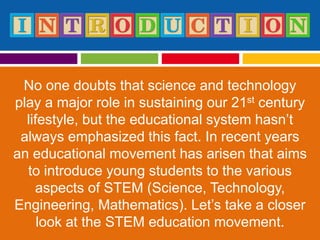
Unveiling STEM Introducing Exciting Learning to Students

Unveiling STEM: Introducing Exciting Learning to Students
Understanding the Essence of STEM
Introducing STEM to students marks a significant shift in educational approaches. STEM encompasses Science, Technology, Engineering, and Mathematics, offering a holistic learning experience that prepares students for the challenges of the modern world. This integration of disciplines fosters critical thinking, problem-solving skills, and innovation from an early age.
Inspiring Curiosity and Exploration
One of the primary goals of introducing STEM to students is to spark curiosity and foster a sense of exploration. By engaging in hands-on activities, experiments, and projects, students develop a passion for learning and a desire to understand the world around them. This experiential approach to education encourages students to ask questions, seek answers, and think critically about complex problems.
Building a Strong Foundation
Introducing STEM to students lays a strong foundation for future academic and career success. By exposing students to foundational concepts in science, technology, engineering, and mathematics, educators equip them with the skills and knowledge needed to pursue advanced studies and careers in STEM-related fields. This early exposure to STEM sets students on a path towards lifelong learning and achievement.
Empowering Future Innovators
STEM education empowers students to become future innovators and problem-solvers. By encouraging creativity, collaboration, and experimentation, educators cultivate an entrepreneurial mindset in students, equipping them with the skills needed to tackle real-world challenges and make a positive impact on society. This emphasis on innovation prepares students to thrive in a rapidly changing world and contribute to the advancement of technology and society.
Cultivating Critical Thinking Skills
Introducing STEM to students fosters the development of critical thinking skills essential for success in the 21st century. Through inquiry-based learning and problem-solving activities, students learn to analyze information, evaluate evidence, and draw logical conclusions. This analytical approach to learning prepares students to navigate complex issues and make informed decisions in their personal and professional lives.
Promoting Diversity and Inclusion
STEM education promotes diversity and inclusion by providing all students with equal access to high-quality educational opportunities. By breaking down barriers and stereotypes, educators create an inclusive learning environment where students from diverse backgrounds feel valued and supported. This diversity of perspectives enriches the learning experience and fosters a culture of collaboration and respect.
Preparing for the Future Workforce
Introducing STEM to students prepares them for the demands of the future workforce. In an increasingly technology-driven world, STEM skills are in high demand across a wide range of industries. By developing proficiency in science, technology, engineering, and mathematics, students gain a competitive edge in the job market and open doors to exciting career opportunities in fields such as engineering, computer science, healthcare, and more.
Embracing Hands-On Learning Experiences
STEM education emphasizes hands-on learning experiences that engage students in active participation and exploration. From building robots to conducting scientific experiments, students learn by doing, gaining practical skills and real-world experience along the way. This experiential approach to learning not only enhances student engagement but also fosters a deeper understanding of STEM concepts and principles.
Encouraging Lifelong Learning
Introducing STEM to students instills a love for learning and a curiosity about the world that extends beyond the classroom. By nurturing a growth mindset and a passion for discovery, educators empower students to become lifelong learners who are eager to explore new ideas, solve complex problems, and make meaningful contributions to society. This love for learning is a lifelong gift that prepares students for success in an ever-changing world.
Investing in the Future
In summary, introducing STEM to students is an investment in the future of education and society as a whole. By providing students with a well-rounded education that emphasizes critical thinking, creativity, and innovation, educators empower them to become leaders and change-makers in their communities and beyond. Through STEM education, students gain the knowledge, skills, and confidence needed to tackle the challenges of the 21st century and create a brighter future for all. Read more about introducing stem to students



